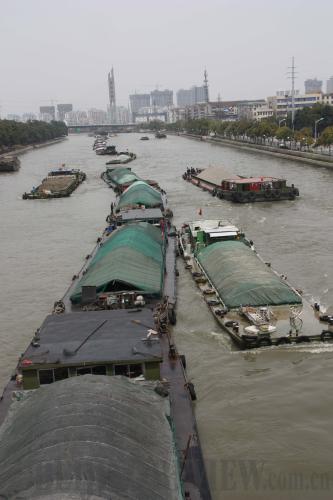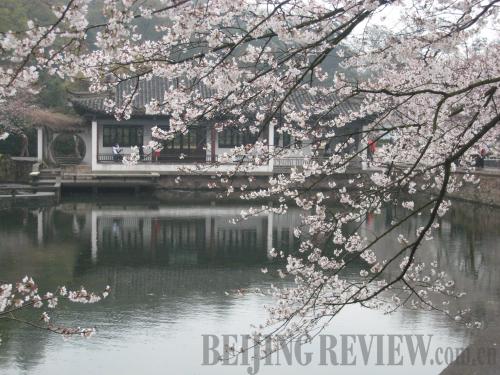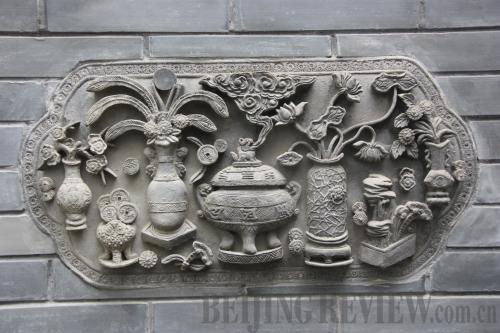|
 |
|
The Wuxi section of the Beijing-Hangzhou Grand Canal (LI YUE) |
On the northwestern bank of Taihu Lake is the Tortoise Head Garden, built in 1916. Covering 539 hectares, which has a 70-year history of cultivating cherry trees and enjoys fame as a leading lakeside resort.
The film and TV production base is located on the southern bank of Lihu Lake—a gourd-shaped inland lake of 8.6 square km—around which a 38-km long scenic passage will be constructed in the near future.
During the Expo, Wuxi will also provide visitors with the convenience of touring the city by bicycle which will be available to rent at more than 30 sites, at a cost of just 5 yuan ($0.75) a day.
To help increase accommodation capacity, the Shanghai Municipal Tourism Bureau has asked Wuxi and six other nearby cities to provide a total of 110,000 hotel beds during the Expo which runs from May 1 to October 31. In response, Wuxi has recommended 43 hotels including five five-star, 10 four-star and 16 three-star hotels, with the number of beds adding up to 9,756. The city's Expo-related hotels reported increased reservations in March, up 21.7 percent from January and February, according to the Expo's official hotel reservation website.
 |
|
Tortoise Head Garden (TANG YUANKAI) | Wuxi is presently in a festive mood following the start of a series of cultural and tourist activities prior to the Shanghai Expo. The Fifth Xu Xiake International Tourism Festival opened on April 16. The City Tourism Day also falls on that day (the third day of the third month on the lunar calendar), marking the first tour of Taihu Lake 403 years ago by Xu Xiake (1587-1641), a well-known geographer, traveler and explorer of the Ming Dynasty (1368-1644). Wuxi is the only Chinese city to have a Tourism Day every year.
The annual Wu Culture Festival is held from April 10 to 17. This year a grand ceremony was performed to offer sacrifices to Taibo who is regarded as the founder of the Wu culture.
 |
|
Clay carving in Wuxi (LI YUE) | Legend has it Taibo was the eldest son of King Tai of Zhou (leader of the Zhou tribe living around Qishan Mountain in the late Shang Dynasty dating back more than 3,000 years). As the first in line, Taibo yielded his position to his third brother Jili and went south along with his second brother Zhongyong. Jili's son Ji Chang, reverently called King Wen, and Ji Chang's son Ji Fa, or King Wu, overthrew the Shang Dynasty (c. 16th-11th century B.C.) and established the Western Zhou Dynasty (c. 11th century-771 B.C.). Trudging more than 1,000 km, Taibo finally arrived at Meili—the present Meicun Town in Wuxi (at least in the opinion of some scholars)—a small village where inhabitants made their living by fishing, hunting and planting rice. Taibo imparted to the local residents knowledge of growing mulberry trees, raising silkworms, baking pottery and smelting bronze—skills that were popular in the Yellow River valley. He also led them in digging a 43-km canal, the first of its type in China's history. Since the time of Taibo, who styled himself Gou-Wu, the Wu culture emerged in an embryonic form in the Yangtze River basin and gradually evolved into a significant sector of the Chinese civilization.
As the birthplace of the Wu culture, in recent years Wuxi has made great efforts to promote both museum construction and eco-environmental protection. At a forum on Cultural Heritage Conservation held in January, Shan Jixiang, Director of the State Administration of Cultural Heritage, acclaimed Wuxi as a "model of relics protection and the restoration of primeval ecology."
Quick Facts on Wuxi
Situated in the southeast of Jiangsu Province, Wuxi City is close to Taihu Lake on the south and to the Yangtze River on the north. Its terrain is mainly flat plains with scattered hills and small mountains. It has a tropical maritime climate characterized by clearly marked seasons. Administering two county-level cities—Jiangyin and Yixing—and seven districts, it covers an area of 4,788 square km and has a permanent population of 6.1million.
In the Yangtze River Delta, Wuxi has a 6,000-year history of civilization, a 3,100-year recorded history and a 2,200-year history of city construction. It is the birthplace of the Wu culture, while China's national industry and commerce and township industry also originated here. It is further noted for Huishan clay figures and boccaro teapots made in Yixing.
A famous garden city attracting myriads of tourists every year, Wuxi has very good transport facilities. A total of 18 domestic and international airlines serve the city's airport. Statistics show the city has 85 high-class hotels, including six five-star, 18 four-star and 36 three-star hotels, and more than 40 economy chain hotels. |
